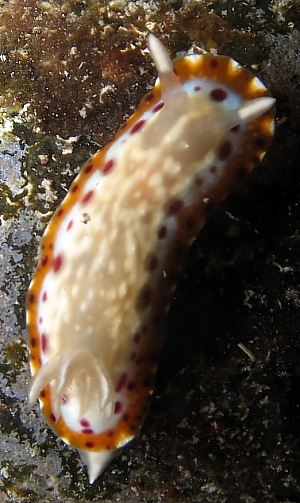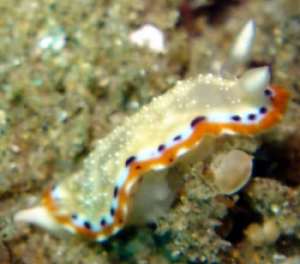
Chromodoris lekker
Gosliner, 1994
Order: NUDIBRANCHIA
Suborder: DORIDINA
Superfamily: EUDORIDOIDEA
Family: Chromodorididae
DISTRIBUTION
Western Indian Ocean - Natal (South Africa), Madagascar, Reunion, Seychelles.
PHOTO
Etang-Salé, Cote Rocheuse, 0.50 m, Reunion Island, Indian Ocean, 1 December 2006. Length: 35 mm. Photographer: Hugues Flodrops.
Chromodoris lekkeri is described as having an opaque white band at the mantle edge, then an orange band and then a purplish white band on which there are dark purple spots. In the one known specimen from Natal, South Africa, there were also purple spots on the orange band. Photos on the Forum have given us a fuller picture of colour variation in the species. As well as the opaque whitish mottling on the mantle ther can alsobe fine white specks. The red-purple spots on the orange border can be absent, and in at least one case the purple spots on the inside of the orange border can be replaced by purple spots on the outside edge.
-
Gosliner, T.M. (1981) Nudibranchs of Southern Africa. Chromodoris sp 4., p.77.
-
Gosliner, T.M. (1994) New species of Chromodoris and Noumea (Nudibranchia: Chromodorididae) from the western Indian Ocean and southern Africa. Proceedings of the Californian Academy of Sciences, 48(12): 239-252.
Rudman, W.B., 2000 (October 15) Chromodoris lekker Gosliner, 1994. [In] Sea Slug Forum. Australian Museum, Sydney. Available from http://www.seaslugforum.net/find/chrolekk
Related messages
Chromodoris lekker feeding observation
August 9, 2007
From: Hugues Flodrops


Dear Bill,
Chromodoris lekker would appear to feed on the purple sponge Chelonaphysilla violacea too. I sent a few weeks ago some pictures of Chromodoris conchyliata eating this sponge [message #19889 ].
Chromodoris lekker also has dark purple spots or patches around the mantle; and the name "conchyliata" meaning "dressed in purple" in Latin. A coincidence? This observation needs confirmation.
Locality: Etang-Salé Permanent Pool, 0,50 metre, Reunion Island, Indian Ocean, 16 juin 2007. Length: 20 mm. Photographer: Hugues Flodrops.
Best regards.
Hugues.
hugues.flodrops@wanadoo.fr
Flodrops, H., 2007 (Aug 9) Chromodoris lekker feeding observation. [Message in] Sea Slug Forum. Australian Museum, Sydney. Available from http://www.seaslugforum.net/find/20406
Dear Hugues,
Thanks for this observation. Hopefully you will be able to confirm that it feeds on this sponge in the future. It is the first observation we have on this species possibly feeding.
Nathalie Yonow, when she described C. conchyliolata, gave it the name "dressed in purple" because of the purple marks on the mantle, both dorsally and ventrally. It belongs to a group of species in which there is a large purple patch on the underside of the anterior mantle. All the species with the large ventral purple patch, for which we have information, feed on C. violacea. I would not consider that the purple markings on the dorsal mantle of C. lekker, which doesn't have the ventral patch, to indicate a relationship with the 'ventral patch' group. Many chromodorids have purple marks on the dorsal mantle.
Best wishes,
Bill Rudman
Chromodoris lekker from Reunion Island
December 4, 2006
From: Hugues Flodrops

Concerning message #12975:
Dear Bill,
Here is a new record of Chromodoris lekker from Reunion Is. It seems that the color pattern is the same as P. Bidgrain's message from Reunion Is..The three photos are the same specimen
Locality: Etang-Salé Cote Rocheuse, 0,50 m, Reunion Island, Indian Ocean, 1 december 2006. Length: 35 mm. Photographer: Hugues Flodrops.
Best regards.
Hugues
hugues.flodrops@wanadoo.fr


Dear Hugues,
Thanks for this record. It is good to get more specimens of this relatively new species. Your animal matches the original description almost identically.
Best wishes,
Bill Rudman
Chromodoris lekker described by Gosliner
October 18, 2005
From: Colin Ogden


Hi Bill,
Here is another new nudi for me. It must be Chromodoris lekker.
Locality: Sodwana Bay, South Africa, Indian Ocean coast. Depth: 12 meters
Length: 30 mm. 15 October 2005. Coral reef. Photographer: Colin Ogden
I am fascinated by the name Terry gave it. One of our local languages is Afrikaans, and in this language the word means "delicious" but has become a slang word used by every one that means extremely good, or very pretty, outstanding or anything that you feel happy about, like instead of having a good day you can have a "lekker" day. Terry obviously learnt this term during his time in South Africa. I have so many people asking me why we cant give the nudi's common names(which was how I used to feel) and I always try to explain the reasons for this, and I think this is a great example of a scientists great sense of humour. I think this is great.
regards
Colin
scubaco@iafrica.com
Ogden C. M., 2005 (Oct 18) Chromodoris lekker described by Gosliner. [Message in] Sea Slug Forum. Australian Museum, Sydney. Available from http://www.seaslugforum.net/find/15032Dear Colin,
Thanks for this find. Yes it certainly fits Terry's description of C. lekker, and
Philbert Bidgrain's photo from Reunion Is [#12975] and Kirsty Miller's from Durban [#4495]. Which leaves us with Valda Fraser's [#3154] also from the east coast of Sth Africa, which has the characteristic white specks, but the red spots are in the wrong place and the yellow band, also in the wrong place, appears to be made by the mantle glands rather than skin pigment, as in C. kitae and C. tumulifera. I guess we will have to wait to see whether it is avariation of C. lekker or a different species.
I'm glad you like 'lekker' as a name. There are quite a few humorous names to be found, unfortunately some are what you might call 'insider jokes' whose meaning will die with those in the know. Others unfortunately have later been shown to be unnecessary, and been replaced by boring 'older' names. One example concerns a little bivalve which & thought belonged to the genus Abra, so they Theora mesopotamica (, 1918).
Best wishes,
Bill Rudman
Chromodoris lekker from Reunion Island
February 18, 2005
From: Philibert Bidgrain

Reunion Island sea slugs.
We have find three specimens of Chromodoris lekker, this one was found by Philibert Bidgrain "Bassin des Hirondelles", a permanent pool at Etang Salé les Bains (Reunion Island), in August 2004, size 15-20 mm.
It looks like Gosliner's photo (N 115 in Nudibranchs of Southern Africa ) The three specimens observed have exactly the same color pattern.
Best Regards
Philibert Bidgrain
http://vieoceane.free.fr/runseaslug/indexslug.htm
pbidgrain@yahoo.fr
Bidgrain, P., 2005 (Feb 18) Chromodoris lekker from Reunion Island. [Message in] Sea Slug Forum. Australian Museum, Sydney. Available from http://www.seaslugforum.net/find/12975Dear Philibert,
This is a good addition to our knowledge of the species
Best wishes,
Bill Rudman
Chromodoris lekker from Durban, Sth Africa
June 6, 2001
From: Kirsty Miller

Dear Bill,
I found this nudibranch at a depth of 3m on a recent dive on Vetches' Pier, a rubble artificial reef at the entrance to Durban Harbour, South Africa.
My father photographed it as part of a school project I am doing. We have identified it from your site as Chromodoris lekker, is this correct?
Kirsty Miller
divegirl@xsinet.co.za
Miller, K., 2001 (Jun 6) Chromodoris lekker from Durban, Sth Africa. [Message in] Sea Slug Forum. Australian Museum, Sydney. Available from http://www.seaslugforum.net/find/4495Dear Kirsty,
Yes it certainly looks like C. lekker. I'll be posting your other interesting finds over the next few days.
Best wishes,
Bill Rudman
Chromodoris lekker from South Africa
October 16, 2000
From: Valda Fraser

Dear Bill
The beauty of this one has me stunned. Could it be a lost Chromodoris rufomaculata?
Locality: Park Rynie, south coast KwaZulu-Natal, SOUTH AFRICA - 28m
Date: October 2000
Size: 15mm
Regards
Valda Fraser
valdafraser@mweb.co.za
Fraser, V., 2000 (Oct 16) Chromodoris lekker from South Africa. [Message in] Sea Slug Forum. Australian Museum, Sydney. Available from http://www.seaslugforum.net/find/3154Dear Valda,
I am pretty sure this is Chromodoris lekker. In Gosliner's description he describes a row of reddish spots on the orange band at the mantle border. In your photo the purple spots are out side the ornage band. He also describes a row of purple spots inside the orange band. In your photo only three faint purple spots can be seen. I know of no other species with the fine white specks. At present it seems we still do not know the full colour variability of this species.
It is also possible we are dealing with a separate but very similarly coloured species. Only more records will give us a clearer understanding. I look forward to Terry Gosliner's views.
Best wishes,
Bill Rudman.
